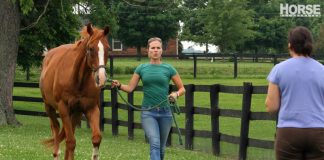Twitching is a method used to subdue horses without the use of drugs. It is frequently used for basic veterinary procedures such as passing a nasogastric tube in a colicky horse. Some handlers will also use i when working with a sensitive horse for things like clipping ticklish area or sheath cleaning. The goal is to make the procedur safer for the horse and humans involved by restraining the horse. Unlike drugs used to calm horses, the effect ends almost immediately after the twitch is removed; no groggy recovery time afterwards.
Twitching Methods
Lip Twitch
A one-man twitch uses essentially the same mechanism, but is a smaller device that clamps on the upper lip, then held closed with a clip or an attached rope that can be clipped to the halter and therefore doesn’t require a second person.
Ear Twitch
Another method of twitching is an ear twitch. This doesn’t use a separate device, but is simply a firm hold applying a slight twist to the ear.
How Twitching Works
The mechanism by which twitching subdues horses isn’t entirely understood. Researchers at Brown University sought to find out more about how lip and ear twitches work. The abstract of their study was published in the September-October 2016 Journal of Veterinary Behavior.
Using a group of 12 geldings, the researchers measured heart rate, heart rate variability, and salivary cortisol levels before and after application of the twitch. An increased heart rate is a possible sign of stress or pain while an increased heart rate variability—the change in interval between heartbeats—is a sign of reduced stress. Elevated cortisol levels are also a sign of a stress response. The aim was to determine stress and pain levels.
Effects of Twitching
The lip twitch caused a decreased heart rate and increased heart rate variability when applied for five minutes, but an increased heart rate and decreased heart rate variability when used for a longer period. There was no significant change in salivary cortisol levels. The researchers say this indicates that the lip twitch subdues horses through a calming, possibly pain-killing effect, but that the effect may be reduced after the first five minutes.
The ear twitch caused horses to have an increased heart rate and decreased heart rate variability regardless of duration. The salivary cortisol levels increased significantly. This suggests that the ear twitch causes a stressful, and likely painful, effect.
While restraining a horse on the fly when no lip twitch is available may sometimes be necessary to prevent an agitated horse from hurting himself or people around him, this research provides some evidence that lip twitching is a preferable method of restraint, when possible.
Twitching in veterinary procedures: How does this technique subdue horses?
Flakoll, B. et al.
Journal of Veterinary Behavior: Clinical Applications and Research , Volume 15 , 88






I hate to see horses twitched… I don’t think its ever necessary if you can calm horses without causing pain.
My horses were ear twitched on the track and lip twitched, and they never forgot, it took years to get them to allow my to pet their ears.
When I first got my horse, I was inexperienced and ignorant…the ‘cowboy’ I boarded with and the old-school vet insisted on twitching every time; and every time, it was a rodeo. I switched barns, gained some wisdom and experience, started using a new vet and for the last 5+ years, my horse has stood quietly, with no twitch, and submitted to his annual shots, etc. Just give them a chance to behave and don’t always assume the worst. Might not work for everyone, but it sure worked for us!!